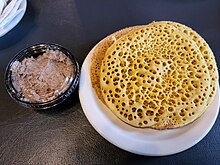
Cajun cuisine is a style of cooking developed by the Cajun–Acadians who were deported from Acadia to Louisiana during the 18th century and who incorporated West African, French and Spanish cooking techniques into their original cuisine.

The cuisine of the Southern United States encompasses diverse food traditions of several subregions, including Tidewater, Appalachian, Ozarks, Lowcountry, Cajun, Creole, African American Cuisine and Floribbean cuisine. In recent history, elements of Southern cuisine have spread to other parts of the United States, influencing other types of American cuisine.

The Acadians are an ethnic group descended from the French who settled in the New France colony of Acadia during the 17th and 18th centuries.

Acadian French is a variety of French spoken by Acadians, mostly in the region of Acadia, Canada. Acadian French has 7 regional accents, including Chiac and Brayon.

Louisiana Creole cuisine is a style of cooking originating in Louisiana, United States, which blends West African, French, Spanish, and Native American influences, as well as influences from the general cuisine of the Southern United States.
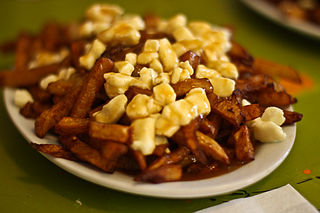
The cuisine of Québec is a national cuisine in the Canadian province of Québec. It is also cooked by Franco-Ontarians.

Canadian cuisine consists of the cooking traditions and practices of Canada, with regional variances around the country. First Nations and Inuit have practiced their culinary traditions in what is now Canada since at least 15,000 years ago. The advent of European explorers and settlers, first on the east coast and then throughout the wider territories of New France, British North America and Canada, saw the melding of foreign recipes, cooking techniques, and ingredients with indigenous flora and fauna. Modern Canadian cuisine has maintained this dedication to local ingredients and terroir, as exemplified in the naming of specific ingredients based on their locale, such as Malpeque oysters or Alberta beef. Accordingly, Canadian cuisine privileges the quality of ingredients and regionality, and may be broadly defined as a national tradition of "creole" culinary practices, based on the complex multicultural and geographically diverse nature of both historical and contemporary Canadian society.

Tourtière is a French Canadian meat pie dish originating from the province of Quebec, usually made with minced pork, veal or beef and potatoes. Wild game is sometimes used. It is a traditional part of the Christmas réveillon and New Year's Eve meal in Quebec. It is also popular in New Brunswick, and is sold in grocery stores across the rest of Canada all year long. It gets its name from the tourte, which is what it was originally made from. Though the name "tourtière" is derived from its filling, the tourte—the French name for the passenger pigeon that is now extinct in North America—was historically used as its filling before the 20th century.

The Acadian World Congress, or Le Congrès Mondial Acadien, is a festival of Acadian and Cajun culture and history, held every five years. It is also informally known as the Acadian Reunion. Its creator was André Boudreau (1945-2005).

Czech cuisine has both influenced and been influenced by the cuisines of surrounding countries and nations. Many of the cakes and pastries that are popular in Central Europe originated within the Czech lands. Contemporary Czech cuisine is more meat-based than in previous periods; the current abundance of farmable meat has enriched its presence in regional cuisine. Traditionally, meat has been reserved for once-weekly consumption, typically on weekends.

Rappie pie is a traditional Acadian dish from southwest Nova Scotia, New Brunswick and areas of Prince Edward Island. It is sometimes referred to as rapure pie, râpée, or râpure. Its name is derived from the French patates râpées meaning 'grated potatoes'. It is a casserole-like dish formed by grating potatoes, then squeezing them through cheesecloth to remove some of the water from the potato solids. The removed liquid is replaced by adding hot broth made from chicken, pork or seafood along with meat and onions, and layering additional grated potatoes over the top. Common meat fillings include beef, chicken, or bar clams.
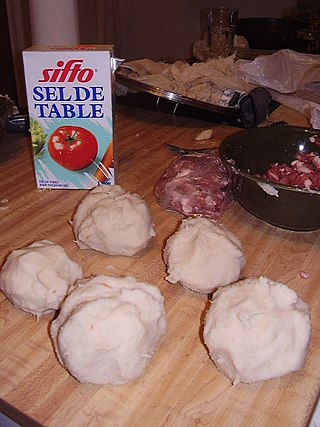
Poutine râpée is a traditional Acadian dish that in its most common form consists of a boiled potato dumpling with a pork filling; it is usually prepared with a mixture of grated and mashed potato.

The Maritimes consist of the provinces of New Brunswick, Nova Scotia and Prince Edward Island. Some of the cuisine has its origins in the foods of the indigenous peoples of the region.
Bermudian cuisine reflects a rich and diverse history and heritage blending British and Portuguese cuisine with preparations of local seafood species, particularly wahoo and rockfish. Traditional dishes include codfish and potatoes served either with an add on of hard boiled egg and butter or olive oil sauce with a banana or in the Portuguese style with tomato-onion sauce, peas and rice. Hoppin' John, pawpaw casserole and fish chowder are also specialties of Bermuda. As most ingredients used in Bermuda's cuisine are imported, local dishes are offered with a global blend, with fish as the major ingredient, in any food eaten at any time.
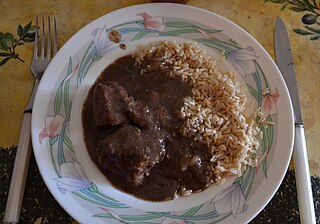
Fricot is a traditional Acadian dish. Fricot is such an important part of Acadian food culture that the call to eat in Acadian French is "Au fricot!"

Acadia is a North American cultural region in the Maritime provinces of Canada where approximately 300,000 French-speaking Acadians live. The region lacks clear or formal borders; it is usually considered to be the north and east of New Brunswick as well as a few isolated localities in Prince Edward Island and Nova Scotia. Some also include a few localities in Quebec and/or Maine.
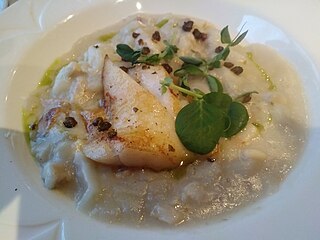
Quiaude is a thick fish soup or chowder traditionally concocted in Gaspésie and sometimes other parts of Maritime Quebec. It came about because of the region's history of commercial fishing.




